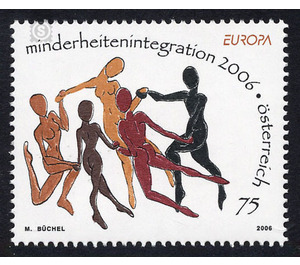Cept - Austria / II. Republic of Austria 2006 - 75 Euro Cent
Theme: History & Politics
| Country | Austria / II. Republic of Austria |
| Issue Date | 2006 |
| Face Value | 75.00 |
| Edition Issued | 450,000 |
| Printing Type | Photogravure |
| Stamp Type | Commemorative |
| Item Type | Stamp |
| Chronological Issue Number | 1941 |
| Chronological Chapter | OOS-OE2 |
| SID | 759763 |
| In 51 Wishlists | |
Immigration and the integration of immigrant minorities are at the center of political conflicts in Europe. Migration challenges the institutions and culture of the liberal Western world. This is not only due to the cultural diversity that migrants bring to political society, but also to the willingness and ability of the majority society to tolerate such diversity. For the Union's political institutions, the integration of migrants aims to articulate as optimally as possible an increasing plurality of interests and lifestyles, increasing ethnic, cultural and religious diversity. The rapidly increasing pressure of immigration from Eastern Europe after the fall of the Iron Curtain or after the eastward enlargement of the EU obliges Europe's countries to adopt a common migration and integration policy. The social integration of young people is not a matter of course. Pluralistic societies that offer a variety of possible lifestyles place high demands on the identity of the individual. Especially for young people with migration experience, who have to find their way between family traditions and the lifestyles described as western, social integration is difficult. They are much more affected by exclusion and are the first to feel the social fault lines, such as: inherited poverty or poverty risk, gender, migration or political system of participation hostility. Concrete examples can be found in the school system, where insufficient educational support, especially in the linguistic area, further worsens the chances. In the world of work, legal requirements - eg. Work permits, citizenship - or lack of teaching and jobs to non-employment or it comes to crowding out in low-paid, often illegal jobs. While the struggle against the economic exploitation of children and adolescents had to be fought one hundred years ago today, the problem of youth unemployment is burdening our society. Employment as one of the central and familiar integration forces has lost considerable momentum. "I hate work because I can not get one!" Is a desperate outcry against structural barriers, such as: These include, for example, the requirements for starting a career, which exclude mainly young people with a migration background. This often also applies to children of the second generation (born in Austria children of foreign parents). About 300,000 children and adolescents in Austria either have a foreign nationality or have recently been naturalized. Their number will increase in the next few years.


